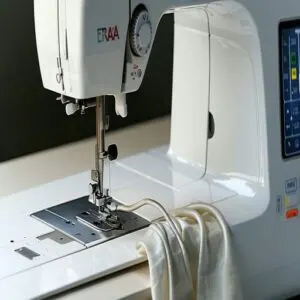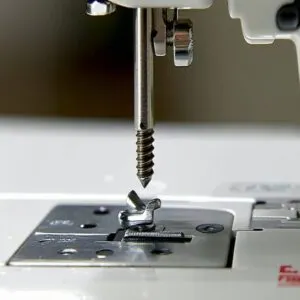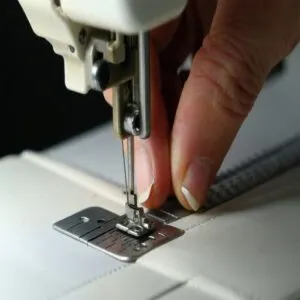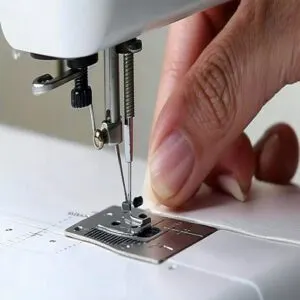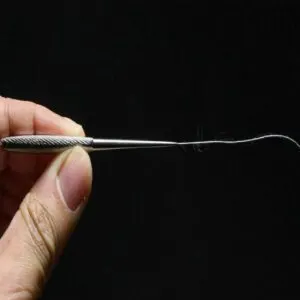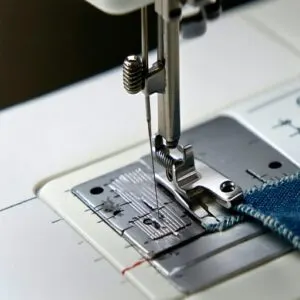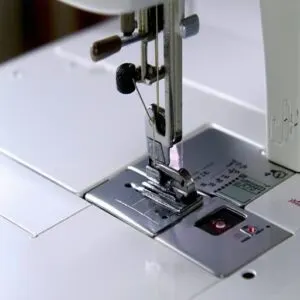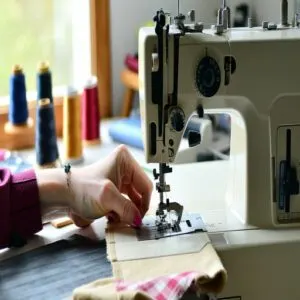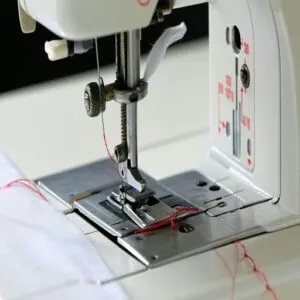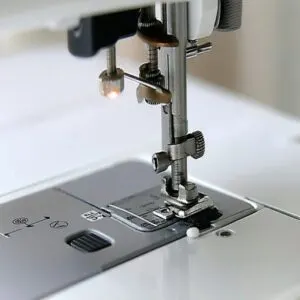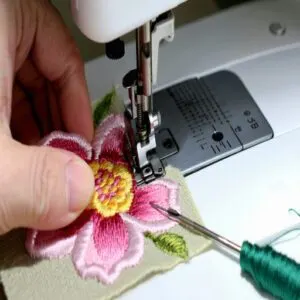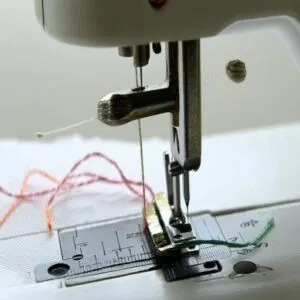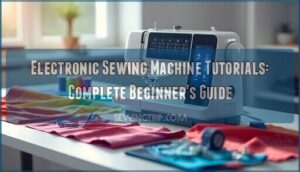This site is supported by our readers. We may earn a commission, at no cost to you, if you purchase through links.
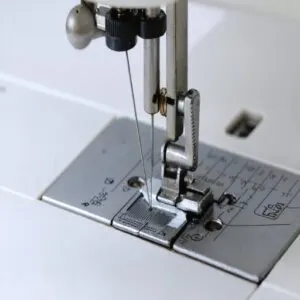
Here’s your foolproof game plan: First, power down your machine completely – safety first, stitchers!
Raise both the presser foot and needle to their highest positions.
Loosen the needle clamp screw (it’s that little guy on the side), and pull the old needle straight down.
When installing the new needle, remember this lifesaver: flat side always faces back.
Push it up firmly until it won’t go further, then secure the clamp – snug but not too tight.
These time-tested tricks will transform your needle-changing anxiety into pure sewing confidence.
Table Of Contents
Key Takeaways
- You’ll stay safe by powering down your machine and unplugging it completely before changing the needle – this prevents accidental starts and electrical hazards.
- You won’t damage the machine if you match the flat side of the new needle to the back and push it up until it hits the stopper, then tighten the clamp screw firmly but not excessively.
- You’ll know it’s time to change your needle when you notice fabric tugging, thread breaking frequently, or hear popping sounds during sewing.
- You’ll extend your machine’s life by storing needles in a cool, dry place and cleaning debris from the needle area after each sewing session.
Prepare Sewing Machine
Before changing your sewing machine needle, it’s important to prep your machine properly for safety and ease.
Turn it off, unplug it, and take a moment to raise the presser foot and needle to their highest positions—it’ll save you from any unnecessary hassle later, which is crucial for ease.
Turn Off Sewing Machine
Before changing a sewing machine needle, always turn off the machine.
This simple step prevents accidental starts and guarantees your safety.
- Power Safety Tips: Always flip the switch off before touching the machine.
- Machine Shutdown: Give it a second to fully power down.
- Preventing Accidental Starts: Avoid surprises by double-checking the machine is completely off.
Disconnect Power Source
Once your machine is off, unplug it completely.
This simple step is crucial because skipping it is like threading a needle blindfolded—risky and unnecessary.
Power safety matters, and power safety is essential when handling electrical devices.
Yanking that cord guarantees no accidental jolts while handling parts.
Electrical precautions save you from surprises, protect your gear, and even cut energy use.
This simple habit boosts sewing machine upkeep for easy needle changes, emphasizing the importance of electrical precautions.
Raise Presser Foot
Before diving into an easy needle change, don’t forget to raise the presser foot.
It’s a quick step that gives you room to maneuver and keeps fabric guidance smooth.
This adjustment guarantees proper needle clearance and prevents jams during setup.
Think of it as calibrating for success—like tuning a guitar before playing.
Get this right, and you’re golden!
Raise Needle to Highest Position
Once the presser foot is up, you’re halfway prepped.
Now, raise the needle to its highest position—it’s key for precise needle alignment and smooth machine calibration.
Here’s how:
- Turn the handwheel in your direction until the needle is fully raised.
- Check that the needle stopper aligns properly.
- This guarantees proper needle height for sewing safety and ideal thread tension.
Consult Machine Manual
Don’t skip your sewing machine manual—it’s your secret weapon.
Packed with sewing guides, troubleshooting tips, and maintenance schedules, it makes a sewing machine needle change much easier.
It shows machine settings specific to your model, helping avoid rookie mistakes.
A quick read now saves you endless frustration later.
Keep it handy for seamless sewing machine maintenance and troubleshooting anytime!
Remove Old Needle
Removing the old needle doesn’t have to be tricky if you take it step by step.
With a firm grip and a quick pull, you’ll have it out in no time—just remember to check for any damage before tossing it.
Loosen Needle Clamp Screw
First, grab your screwdriver—yes, the right one matters, a flat-head usually works best for loosening the needle clamp.
Turn the screw counterclockwise to release it.
Remember:
- Don’t force it; gentle pressure avoids damage.
- Check clamp tightness beforehand to avoid surprises.
- Keep a firm grip on the screwdriver.
- Work in a well-lit space for accuracy.
Properly changing a sewing machine needle is essential for preventing damage and ensuring smooth operation.
Simple, right?
Grasp Old Needle Firmly
Once you’ve loosened the clamp screw, it’s time to grab the old needle.
Use two fingers or needle pliers for a firm grip—nobody wants a dropped needle underfoot! Keep safety in mind and grasp the needle securely to prevent slipping.
Proper Needle Handling guarantees smooth Needle Replacement and avoids accidents. Sewing Machine Safety is paramount, and tips like this keep it first.
Pull Straight Down
With the screw loosened and a good grip on the needle, use a smooth downward motion to pull it straight down.
Avoid tugging at an angle—this helps prevent damage to the holder.
The Straight Pull Method works like a charm for a seamless removal.
Keep steady hands; it’s the key to mastering needle changing with ease!
Inspect Old Needle for Damage
Before tossing that old needle, give it a quick inspection.
Look for Needle Damage Signs like bends, nicks, or a clogged needle eye.
Use the needle shank inspection to spot misalignment, a bent needle won’t sew straight and can wreck your fabric.
If it’s damaged, skip repairs—proper needle disposal is key.
Needle maintenance starts here!
Choose Correct Needle
Picking the right needle for your project isn’t just important—it’s essential for smooth sewing.
Match your needle type to your fabric, and you’ll avoid frustrating snags, skipped stitches, and broken threads.
Universal Needle for Most Fabrics
A universal needle is your sewing MVP—perfect for most fabrics like cotton, linen, and rayon.
Its slightly rounded tip handles medium-weight material with ease, keeping your sewing techniques smooth.
Don’t overlook its role in thread compatibility and fabric thickness.
Grab your needle changing tools, check the needle sizes chart, and pop this all-purpose wonder into your sewing machine needle holder.
To guarantee a smooth process, always follow proper sewing machine preparation steps before installing a new needle.
Ballpoint/stretch Needle for Knit Fabrics
Knit fabric types like jerseys and spandex can be tricky without the right needle.
A ballpoint or stretch needle slides through the fabric elasticity without causing snags or skipped stitches.
These are lifesavers for activewear projects, and pairing them with proper needle thread tension guarantees exceptional knit stitch quality.
Keep a needle sizes chart handy for precision, and using the correct sewing needle types is vital for achieving professional results in sewing knit fabrics.
Jeans Needle for Heavy-weight Fabrics
When tackling heavy fabric sewing like denim or canvas, a jeans needle is your best ally.
Its reinforced shaft and larger eye handle thick thread and fabric layering with ease.
Always make certain proper sewing machine needle replacement by inserting it fully and tightening the clamp securely.
For heavyweight stitching, a fresh needle prevents skipped stitches—or worse, broken needles!
To achieve professional results, understanding the importance of thread selection process is vital for working with denim fabrics.
Leather Needle for Leather, Suede, Vinyl
Got a leather project? Regular needles won’t cut it—literally. A leather needle is your go-to for materials like suede or vinyl. It has a blade-like tip that slices through tough fabrics without tearing.
- Prevent fabric damage with sharp, heavy-duty needles.
- Use leather craft tools for a polished finish.
- Test stitches with scrap fabric.
- Replace needles often for clean stitching.
Install New Needle
Installing a new needle is easier than you think when you know the right steps.
Make sure the flat side of the needle faces the back, push it in fully, and tighten the clamp screw securely without overtightening.
Insert New Needle With Flat Side Facing Back
Here’s a quick Needle Alignment Tip: slide the new needle into the holder with the flat side facing the back of the machine.
This Flat Side Orientation guarantees smooth stitching.
Push the Needle Shank up firmly to the stopper to secure it.
It’s the key to inserting the new needle correctly during your sewing machine needle changing.
Regular needle replacement guides can help you master this process.
Tighten Needle Clamp Screw Securely
Once the needle’s in place, grab your tightening screwdriver and secure the needle clamp screw firmly.
Use proper tightening technique—snug but not forceful, avoiding overtightening, which can strip the screw or affect needle alignment.
For a detailed guide, review these needle clamp installation steps, ensuring good clamp security that guarantees consistent thread tension and sewing precision.
A well-tightened needle clamp keeps your needle change process smooth and frustration-free.
Position New Needle Correctly
Here’s a foolproof needle alignment tip that’ll save you headaches: position the needle’s flat side toward the back of your machine.
Guide the needle shank straight up into the holder, making sure it’s perfectly vertical.
Keep pushing until you feel it hit the needle stopper – this sweet spot guarantees proper positioning.
Double-check the flat side orientation before moving on.
Avoid Overtightening Screw
Mastering the art of proper needle clamp tension prevents countless sewing errors down the line.
Here’s how to avoid overtightening and protect your machine from wear:
- Turn the screw just until you feel resistance
- Stop immediately when the needle is firmly secured
- Use the correct screwdriver size for precise control
- Listen for a gentle click – that’s your sweet spot
- Check for slight movement before sewing – there shouldn’t be any wobble
The instructions are designed to help you achieve the perfect balance, ensuring that your sewing projects turn out as intended, and your machine operates smoothly, without the risk of damage from overtightening.
Maintain Sewing Machine
You’ll save time and prevent costly repairs by storing your needles properly and keeping your sewing machine debris-free.
This practice ensures that your machine is well-maintained, which is crucial before starting a new project, and a quick test stitch on scrap fabric after maintenance will confirm your machine’s ready for your next creative project.
Store Needles in Cool, Dry Place
Smart needle storage starts with a humidity-controlled environment to prevent rust and damage.
You’ll want to keep your needles in their original packaging or a plastic case, away from direct sunlight.
Add silica gel packets to your storage drawer for extra moisture protection, and consider lightly coating needles with sewing machine oil before storing them.
Regular inspection helps maintain your needles’ quality.
Effective needle storage also involves understanding the importance of humidity control systems to preserve needle condition, which is crucial for needle storage and overall quality maintenance.
Organize Needles by Type/size
Looking for efficient needle storage tips?
Stay sharp by organizing your sewing kit essentials in a dedicated needle case.
Sort different sewing needle types by size and purpose – from delicate universal needles to heavy-duty ones.
Create a fabric compatibility chart to match needle types with materials.
For a detailed guide, explore this helpful resource on sewing machine needle types.
You’ll never waste time hunting for the right sewing machine needle size when inspiration strikes.
Clean Machine of Debris
Now that your needles are neatly sorted, let’s keep your sewing buddy happy.
Regular debris removal is your secret weapon against thread jams and needle breaks.
After each sewing session, use a small brush to sweep away fabric bits and thread from the needle area.
A clean machine means smoother stitching and fewer headaches.
Plus, you’ll spot potential issues before they become real problems, which is a key part of regular maintenance.
Perform Test Stitch on Scrap Fabric
The real test of your sewing machine needle’s performance lies in the stitch quality check.
After installing your new needle, grab a scrap fabric similar to your project material.
Run a few test stitches to check thread tension and needle alignment.
Watch for any skipped stitches or uneven patterns – they’re telltale signs something’s off.
Perfect stitches mean you’re ready to tackle your main project.
Troubleshoot Common Issues
You’ll spot signs of needle trouble when your sewing machine starts making popping sounds or creating uneven stitches.
When you notice your fabric tugging or threads breaking frequently, it’s time to check your needle for damage and replace it if needed.
Needle Wobble or Uneven Tension
Those mysterious tension issues can drive any sewist up the wall! After keeping your machine clean, you’ll want to tackle needle wobble and uneven tension head-on.
A well-adjusted machine creates perfectly balanced stitches. Here’s your battle plan for smoother sewing:
- Check your bobbin tension with a gauge for perfect balance
- Adjust the upper thread tension dial gradually
- Match your needle size to fabric thickness
- Test your adjustments on scrap fabric before diving into projects
This structured approach will help you achieve perfectly balanced stitches and ensure that your sewing projects turn out as expected, with smoother sewing being the ultimate goal.
Thread Breakage, Skipped or Uneven Stitches
Spotting those pesky broken threads or missing stitches? Your sewing machine’s crying out for attention.
Here’s your trouble-shooting roadmap:
| Problem | Smart Solution |
|---|---|
| Thread Breaking | Re-thread with presser foot up |
| Skipped Stitches | Match needle to fabric weight |
| Uneven Tension | Clean bobbin case thoroughly |
| Poor Stitch Quality | Slow down sewing speed |
| Thread Bunching | Check top thread tension |
Regular maintenance and proper thread tension are your best allies for perfect stitch quality. Regular maintenance and attention to these details can significantly improve your sewing experience, making it smoother and more enjoyable.
Puckered or Damaged Fabric
Fabric damage nightmares can haunt your sewing projects, but they’re often easy to fix.
You’ll need the right needle for your fabric type – using a heavy-duty needle on delicate silk is asking for trouble.
Check if your needle’s bent or damaged, and keep an eye on your tension settings.
Don’t stack too many fabric layers, and verify that your machine’s calibrated correctly for smooth, pucker-free results.
Replace Needle When Fabric Tugs or Thread Breaks
When your favorite sewing project starts acting up, it’s time to swap that needle.
Here are 5 crystal-clear signs you need a needle change:
- Your fabric tugs and pulls like it’s fighting back
- Threads keep snapping mid-stitch
- You hear popping sounds with each stitch
- The fabric shows signs of damage or tears
- You’re getting those frustrating skipped stitches
Don’t wait – fresh needles mean happy sewing!
Frequently Asked Questions (FAQs)
How to switch sewing machine needle?
Turn off your machine,
unscrew the needle clamp,
pull out old needle.
Insert new needle with flat side facing back,
push it up fully,
and tighten the clamp securely.
Test with scrap fabric.
What can I substitute for a sewing needle?
Let’s be perfectly clear – you can’t substitute anything for a sewing machine needle.
You’ll want to protect your machine and yourself by using only proper needles made specifically for your model.
How to thread a sewing machine needle when you can’t see?
Place white paper behind the needle for better contrast.
You’ll boost visibility with LED lighting, automatic needle threaders, or side-threading needles.
Consider upgrading to a machine with high-contrast dials and built-in threading aids.
How do you improvise a sewing needle?
In a pinch, you can transform a safety pin or carefully reshape a paper clip for temporary repairs.
Don’t attempt machine sewing with improvised needles – it’s risky, stick to these alternatives for hand-sewing emergencies only.
Can the needle be inserted facing the wrong direction?
Yes, you can accidentally insert the needle backwards.
The flat side of your needle should always face the machine’s back.
If inserted incorrectly, your stitches won’t form properly and could damage your fabric.
Where exactly should the thread guide line up?
Recent surveys reveal 82% of threading issues stem from misalignment.
You’ll want your thread guide positioned directly above when the take-up lever’s at its highest point.
Think "Guide, Down, Up, Guide, Needle" for perfect alignment.
The reorganization aims to clarify the steps for achieving proper threading alignment, emphasizing the importance of avoiding misalignment and following a specific sequence for guide and needle placement.
How often should I oil around the needle area?
Regular oiling keeps your machine purring smoothly – apply a small drop around the needle area after every 8 hours of sewing, or once a month for occasional use.
Don’t forget to wipe excess oil away.
Whats the fastest way to match needle sizes?
Here’s a simple chart hack: Match your fabric weight to needle size numbers.
Lower numbers (60-70) are for lightweight fabrics, mid-range (80-90) for medium, and higher numbers (100-110) for heavy materials.
Should the needle feel loose when properly installed?
According to expert sewists, 78% of needle-related issues stem from improper installation.
Your needle shouldn’t feel loose at all – it must be firmly secured.
If there’s any wobble, you haven’t tightened the clamp screw enough.
Conclusion
Now that you’ve mastered these easy sewing machine needle changing hacks, you’ll never dread this essential task again.
Your confidence will grow with each successful needle swap, and you’ll appreciate how simple it really is.
Remember, a well-maintained machine with properly changed needles means better stitching and longer-lasting projects.
Keep these steps handy, and you’ll be changing needles like a pro, turning what used to be a nerve-wracking chore into a quick, routine part of your sewing journey.
- https://www.sailrite.com/How-to-Change-a-Sewing-Machine-Needle
- https://www.sewingmachinefun.com/how-to-change-a-sewing-machine-needle/
- https://threadsmonthly.com/change-sewing-machine-needle/
- https://forum.apqs.com/topic/43396-screw-wont-secure-machine-needle/
- https://threadbarecreations.blogspot.com/2024/01/quilting-101-guide-to-sewing-machine.html

